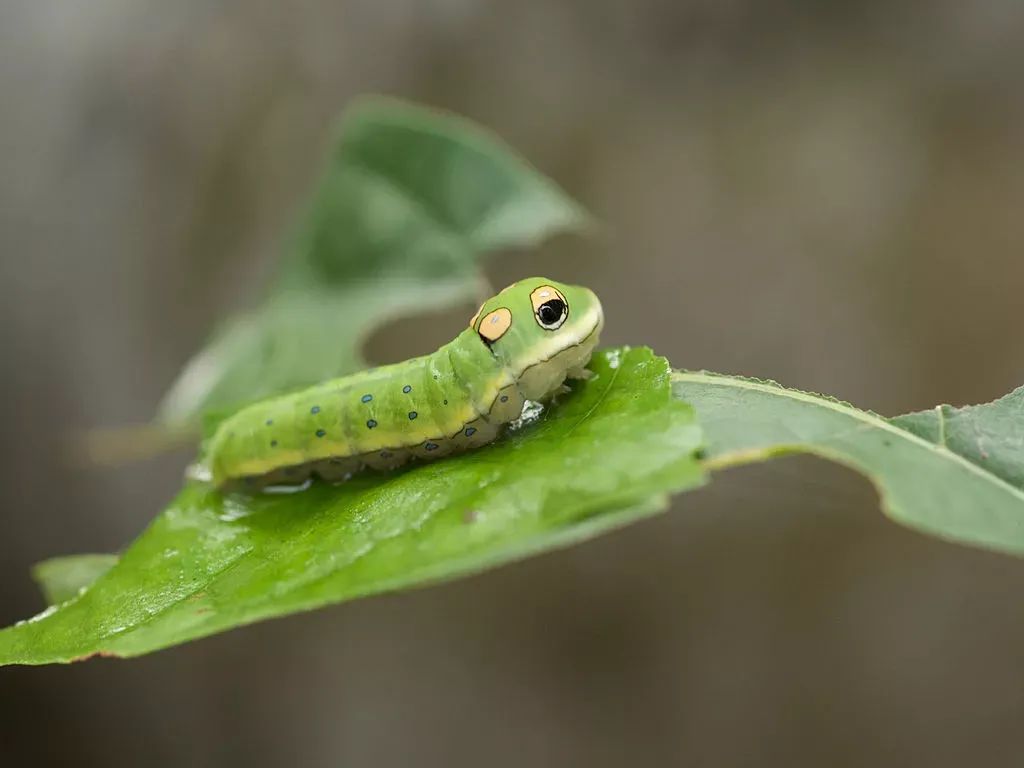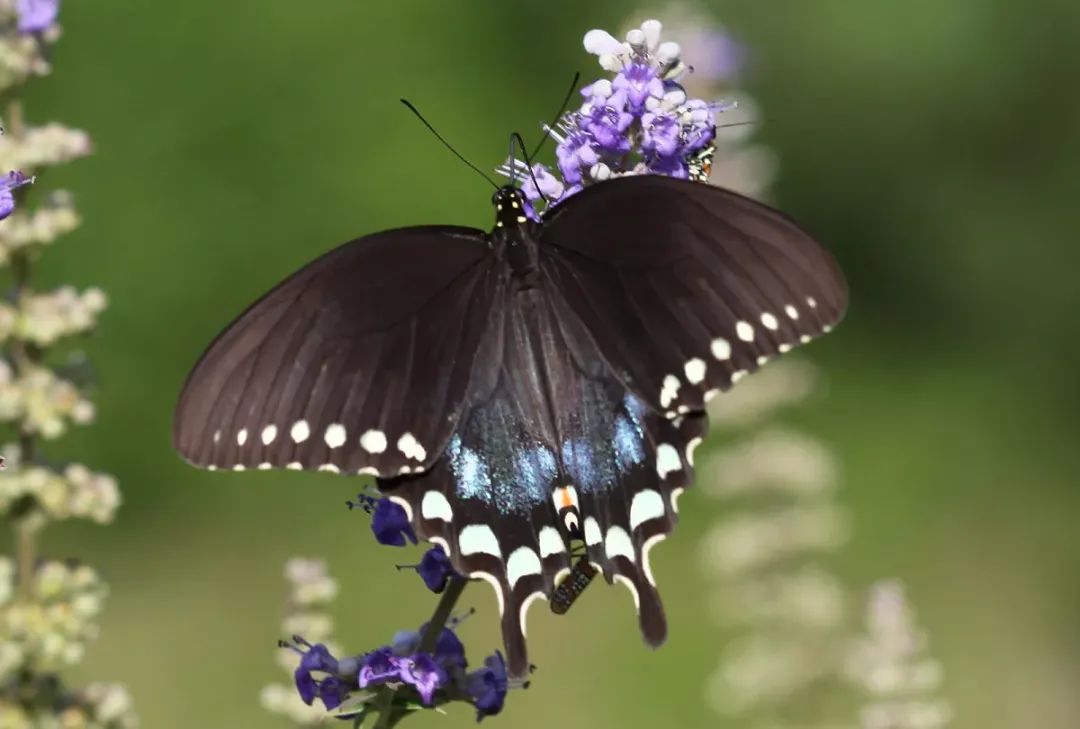Amazing transformation of ten caterpillars, from larvae to adults, marvel at the wonders of natural evolution
The graceful dance of butterflies and moths, with their lightness and fragility, can easily capture people's hearts. However, their colorful life starting from the larval stage, whether in color, shape, patterns, or armor, is equally full of charming charm. All larvae undergo a stunning metamorphosis journey during their transition from eggs to adults.
Spice shrub swallowtail butterfly larvae
At first glance, these striking green larvae resemble small snakes or tree frogs, a clever disguise used to deceive predators. The most striking feature is their false eye spots, which are black circular spots that are not real eyes, but the intricate details of their mimicry, including the black pupil in the center and the surrounding white highlights, seem to reflect light, which is breathtaking. If this; The Eye of Evil; In the event of a failed deterrence, the larvae of the spice shrub swallowtail butterfly will also display their bright yellow, stretchable horn like organs (called scent glands) behind their heads, which contain chemicals to drive away enemies.


These striking creatures can be seen everywhere in the eastern United States, hiding in folded leaves during the day and coming out to forage at night. Their preferred plants include Red Bay, Dalbergia, and spice shrubs. In the end, they transformed into large, colorful black butterflies, with blue patches and rows of light colored spots dotted around the edges of their wings.
Walnut Horn Moth Larvae
The larvae of the walnut horned moth may appear powerful, but they are actually harmless and can grow over 12 centimeters in length. Their shocking turquoise colored bodies are covered in black spikes and prickly orange horns, all of which are awe inspiring. However, all these external threats are actually just a bluff.


They live in the forests of the eastern United States and feed on the leaves of walnuts, ash, persimmons, wutong trees and walnut trees. At the end of summer, they will burrow several inches deep underground. They are one of the few moths larvae that do not form cocoons. In the following summer, they transform into magnificent moths in shades of orange, gray, and cream, with a wingspan width of up to 15 centimeters.
Emperor butterfly larvae
When spring arrives, female emperor butterflies will lay eggs on milkweed plants. After hatching, these striking orange, black, and white striped larvae will first eat the nutrient rich eggshell, and then begin to feast on the leaves of milkweed. During this process, they also ingested toxins called cardiac glycosides, which are harmless to them but deadly to predatory birds. In just two weeks, their volume can grow to 3000 times its original size.


After a full meal, mature larvae will attach to leaves or stems, transform into pupae, and appear in the beautiful butterfly form of orange, black, and white that we are familiar with a few days later. The emperor butterfly is widely distributed in North America, Central America, South America, Australia, Western Europe, and India. Every autumn, they undergo a large-scale migration to their wintering grounds along the coasts of Mexico and California.
Cat caterpillar
These furry little ones look cute, but touching them can be very dangerous. Cat caterpillars are one of the most toxic caterpillars in the United States. Their wig like fur hides toxic spines, which can cause severe pain upon contact with the skin, even more severe than bee stings. Symptoms may include swelling, headache, fever, nausea, vomiting, and even shock or difficulty breathing. The more mature the caterpillar is, the more severe its sting becomes.


Cat caterpillars eventually transform into southern felt moths, with their wings, legs, and bodies covered in yellow, orange, and cream colored fur. They hatch from extremely tough cocoons, which may still hang on trees long after the moth flies away, or even be covered with lichens.
Zebra long winged butterfly larvae
These powerful looking larvae feed on the leaves of several types of passion fruit. This dietary preference is not just for nutrition; It also helps to protect oneself from predators. Passion fruit contains toxins and bitter hallucinogenic alkaloids. By consuming these plants, zebrafly larvae also become bitter and toxic in taste, which is visually enhanced by the black spots and long black spines on their backs.


These impressive creatures are common in Central America, Mexico, Florida, and Texas, eventually transforming into enchanting butterflies adorned with black and pale yellow stripes.
Saddleback caterpillar
The name of this caterpillar comes from the bright green color on its back; Saddle”, The edge is white with a purple brown oval spot in the middle. These bright colors are warning signals from nature. These uniquely shaped creatures, although only 2.54 centimeters long, have a formidable ability to sting.


Be wary of the four venomous spines in front and behind them (the first two, the last two), as well as the many smaller protrusions arranged along their sides. In contrast, mature saddle backed caterpillar moths appear as gentle as their appearance.
Owl butterfly larvae
These brown larvae living in rainforests in Central and South America can reach a length of 15.24 centimeters before transforming into impressive butterflies. They feed on banana leaves and sugarcane, so much so that they are considered pests near plantations.


Owl butterflies are known for their love for fermented fruits, as well as the fake owl eyes on their wings, including pupils and irises, which are perfectly designed to scare away predatory birds and lizards.
Silkworm moth larvae
These plump green big guys can be seen everywhere in the United States and Canada, with lengths exceeding 10.16 centimeters. As they gain weight, their color changes from black to bright sea green, and ultimately to rainbow like blue-green. The most striking feature is the numerous blue, orange, and yellow protrusions (small tumors) on their bodies, holding black spines. Although they may look scary, all of this is just a show of strength.


The larvae of the silkworm moth do not sting or cause harm to humans. They spend the whole summer eating leaves and then make a cocoon to get through the winter. When larvae hatch for the first time, they are black, but as they molt continuously, they turn yellow and eventually green. In spring, they become one of the largest moths in North America and also one of the most spectacular species.
Keynes bird wing butterfly larva
These prickly Indigenous peoples of northeastern Australia began their lives on the leaves of a rainforest vine called Aristolochia. Although this vine plant is toxic to other larvae and humans, Keynesian bird wing butterfly larvae can thrive on it.


In fact, they store the ingested toxins in the fleshy orange, yellow, and red spines on their backs as a deadly defense against predators. The color of the spines is enough to prevent hungry birds from swallowing them. The butterflies they transform into are the largest in Australia, especially males, known for their bright and colorful appearance.
Witch moth (monkey slug) larvae
At first glance, you may mistakenly think that the witch moth larva is a furry spider. The more common name is monkey slug larva, which is completely unique. It has a flat furry brown body, six pairs of curled tentacle like legs (three short and three long), and furry protrusions that grow from the head. These hairs can cause irritation and allergic reactions, especially in sensitive individuals.


It is interesting that when these larvae make cocoons, their appendages are transferred outside the cocoon to provide protection and camouflage. This peculiar looking larva eventually transformed into a less peculiar and harmless witch moth, with a small furry body and pale clusters on its legs.